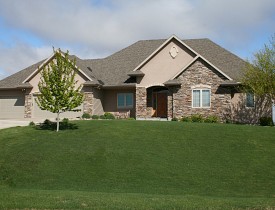Making the Right Landscaping Choices for Curb Appeal
 As much as we like to encourage people to use low-water landscaping techniques and to eschew the traditional lawn in favor of permaculture gardens and sustainable cover crops, there is a bit of data to contend with regarding home sales.
As much as we like to encourage people to use low-water landscaping techniques and to eschew the traditional lawn in favor of permaculture gardens and sustainable cover crops, there is a bit of data to contend with regarding home sales.
According to quite a few reliable sources, curb appeal still means (to the majority of buyers) a lush green lawn. We set out to find out which enhanced home value more: lawns or gardens. Specifically, we wanted to find out what a better investment would be for homeowners who are trying to sell.
How important is professional landscaping?
A well-designed and well-tended yard can attract more potential buyers and higher values. Almost 20 percent of buyers said professional landscaping was "very important" in a National Association of Realtors survey for the 2007 Profile of Buyers' Feature Preferences, according to NAR spokesman Walter Molony.
Moreover, 32 percent of those looking for new homes want professional landscaping, and half of those buyers who cite professional landscaping as a priority ultimately bought a home with professional landscaping.
In her book “Home Rich,” Gerri Willis cites a Clemson University study that found attractive landscaping adds 6 to 7 percent to a home’s sale value. She said other studies suggest value boosts of up to 15 percent.
Good landscaping investments
In adding garden features around the home, focus on curb appeal, energy savings and attractively framing the home. When in doubt, a nicely manicured lawn has universal appeal. HGTV's curb appeal maven Terry Hass said on Hometalk.com, "You have 7-10 sec[onds] to make a first impression -- make it count. Lots of color in lanscaping -- no yard ornaments."
Consider planting some flowers at the curb or in strips along the driveway. Add some attractive bark mulch in sparse flowerbeds and other landscaped areas. Also consider some shrubs or other plantings along the home’s foundation, particularly if it is bare and exposed.
Keep in mind that landscaping does not look the same in every season. Sid Davis, author of “Home Makeovers That Sell,” suggests taking photos of your flowerbeds and other areas in full bloom in spring and summer, and including them in a sales packet during other, less colorful seasons.
Trees and shrubs can also provide significant energy savings, which are important to a growing number of home buyers. The National Association of Realtors 2010 Profile of Home Buyers and Sellers shows that 88 percent of home buyers considered heating and cooling costs somewhat important or very important. Moreover, almost 50 percent considered landscaping for energy savings somewhat or very important. Deciduous plants near windows and walls can block the heat of the summer sun, substantially reducing air conditioning bills, while allowing passive solar heating in the winter.
On the other hand, messy, overgrown trees and shrubs can block the view of the home from the street, reducing curb appeal. Trees and shrubs should complement and frame the house without dwarfing or obscuring it.
Also, like most other upgrades, it’s important to keep up with the Joneses, but not to vastly outspend the Joneses. Make sure the landscaping suits the neighborhood without pricing yourself out of the market. It may be hard to recoup the investment of the only outdoor kitchen on the block.
Lawns must be in good shape
Davis notes that homes often sell for top dollar with nothing but a lawn — a lush, manicured lawn. He suggests that buyers appreciate that the hard work of planting the lawn and installing sprinklers is done, and they can easily add some flowerbeds and garden features.
Weeds are a no-no when it comes to curb appeal. There are quite a few ecologically sound ways to remove weeds, including biological control, mulching and reseeding bare patches. Fertilizing is a good defense against weeds. Add some nitrogen-rich fertilizer, and consider getting a soil test to determine other nutrients that may be lacking. Keep the lawn neatly mowed, but not too short, as this is unattractive and bad for the lawn. Also, keep it adequately watered, and trim neatly around the edges.
Don’t hide problems, fix them
Even professionally maintained lawns and gardens can’t hide a serious problem. Grading problems are among the most common red flags for homebuyers, according to the National Association of Home Inspectors. Inspectors will find incorrect grading no matter how green the grass or neatly trimmed the topiary, and it could cause the house to fail the inspection.
Make sure the soil slopes away from the house. Also avoid both lawns and gardens directly adjacent to the house, as they require and retain water that can seep into the foundation. A rock border and downspout extensions can keep water away from the house.
Trees towering over the home can also scare away buyers. Consider getting the trees inspected and trimmed by a professional arborist, and offer potential buyers documentation of their work. This can set their mind at ease that the trees are not going to fall on the house or be very costly to trim and maintain. The same goes for large trees near sewer lines. Inspecting and clearing those lines can offer peace of mind for both the seller and potential buyers.
Steve Graham is a Networx - https://www.networx.com - writer. Get home & garden ideas like this - https://www.networx.com/article/making-the-right-landscaping-choices-for - on Networx.com.
Looking for a Pro? Call us (866) 441-6648

Landscaping Average Costs
Landscapers Experiences

Seamless Extension Of Concrete Patio And Poolside Retaining Wall

Fast Professional Tree Service For My Crabapple And Persimmon



